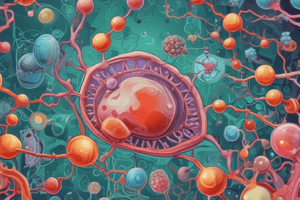Podcast
Questions and Answers
Which type of lipids are insoluble in water but soluble in nonpolar solvents?
Which type of lipids are insoluble in water but soluble in nonpolar solvents?
- Prostaglandins
- Complex lipids (correct)
- Simple lipids
- Steroids
Which of the following is NOT a classification by structure for lipids?
Which of the following is NOT a classification by structure for lipids?
- Simple lipids
- Monoglycerides (correct)
- Steroids
- Complex lipids
In terms of structure, which lipid category includes prostaglandins, thromboxanes, and leukotrienes?
In terms of structure, which lipid category includes prostaglandins, thromboxanes, and leukotrienes?
- Simple lipids
- Glycolipids
- Complex lipids (correct)
- Steroids
What is the classification of lipids based on function?
What is the classification of lipids based on function?
What is the primary function of simple lipids?
What is the primary function of simple lipids?
Which type of lipids are vital components of cell membranes?
Which type of lipids are vital components of cell membranes?
Which lipid class is involved in cell signaling and as precursors to bioactive molecules like hormones?
Which lipid class is involved in cell signaling and as precursors to bioactive molecules like hormones?
Which lipids are known for their role in inflammation and immune responses?
Which lipids are known for their role in inflammation and immune responses?
Flashcards are hidden until you start studying
Study Notes
Lipids
- Lipids are a family of substances that are insoluble in water but soluble in nonpolar solvents and solvents of low polarity, such as diethyl ether.
Classification of Lipids
- Classification by Function:
- Storage
- Membrane Components
- Messenger
- Classification by Structure:
- Simple lipids (fats, oils, and waxes)
- Complex lipids
- Steroids
- Prostaglandins, thromboxanes, and leukotrienes
Glycerophospholipids
- A glycerophospholipid is a lipid that contains two fatty acids and a phosphate group esterified to a glycerol molecule and an alcohol esterified to the phosphate group.
- Glycerophospholipids have four ester linkages.
Sphingolipids
- No specific information provided in the text.
Glycolipids
- No specific information provided in the text.
Steroids
- The third major class of lipids, which are compounds containing a specific ring system.
- Cholesterol is the most abundant steroid in the human body and the most important.
- Lipoproteins are carriers of cholesterol:
- High-density lipoprotein (HDL) (“good cholesterol”)
- Low-density lipoprotein (LDL) (“bad cholesterol”)
- Very-low-density lipoprotein (VLDL)
- Chylomicrons
Structures and Properties of Triglycerides
- Two types of triacylglycerols:
- Simple triacylglycerols: three identical fatty acids are esterified
- Mixed triacylglycerols: a triester formed from the esterification of glycerol with more than one kind of fatty acid
- Physical state of triglycerides varies depending on the fatty acid composition.
- Saponification: base-promoted hydrolysis of fats and oils producing glycerol and a mixture of fatty acid salts called soaps.
Role of Lipids in the Structure of Membrane
- Lipids play a crucial role in the structure of membranes, with complex lipids forming bilayers.
Studying That Suits You
Use AI to generate personalized quizzes and flashcards to suit your learning preferences.




